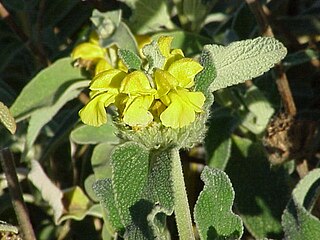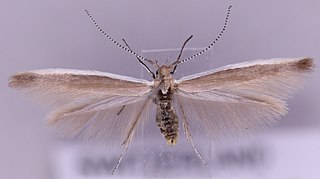
Phlomis is a genus of over 100 species of herbaceous plants, subshrubs and shrubs in the family Lamiaceae, native from the Mediterranean region east across central Asia to China.

The Coleophoridae are a family of small moths, belonging to the huge superfamily Gelechioidea. Collectively known as case-bearers, casebearing moths or case moths, this family is represented on all continents, but the majority are found in temperate areas of the Northern Hemisphere. They are most common in the Palearctic, and rare in sub-Saharan Africa, South America, and Australia; consequently, they probably originated in northern Eurasia. They are relatively common in houses, they seek out moist areas to rest and procreate.

Coleophora is a very large genus of moths of the family Coleophoridae. It contains some 1,350 described species. The genus is represented on all continents, but the majority are found in the Nearctic and Palaearctic regions. Many authors have tried splitting the genus into numerous smaller ones, but most of these have not become widely accepted.

Phlomis fruticosa, the Jerusalem sage, is a species of flowering plant in the family Lamiaceae, native to Albania, Cyprus, Greece, Italy, Turkey, and countries of the former Yugoslavia.

Coleophora serratella is a moth of the family Coleophoridae. It is found in Europe, Japan (Hokkaido) and North America.

Coleophora limosipennella is a moth of the family Coleophoridae described by Philogène Auguste Joseph Duponchel in 1843. It is found in Europe from Fennoscandia to the Pyrenees, Italy and the Balkan Peninsula and from Great Britain to the Baltic States and Romania. It is an introduced species in North America.

The metallic coleophora moth is a moth of the family Coleophoridae. It is native to Europe and Armenia, but is an adventive species in the Nearctic realm, where it is found throughout the United States and southern Canada. It has also been recorded from New Zealand, Chile and Argentina.

Coleophora albicostella is a moth of the family Coleophoridae. It is found from Latvia to the Iberian Peninsula, Italy, Greece and Cyprus.

Coleophora auricella is a moth of the family Coleophoridae. It is found from Germany and Poland to Spain, Italy and Romania. It has also been recorded from southern Russia.

Coleophora lineolea is a moth of the family Coleophoridae. It is found in most of Europe.
Coleophora phlomidella is a moth of the family Coleophoridae. It is found in southern Russia and central Asia.
Coleophora phlomidis is a moth of the family Coleophoridae. It is found in Romania, southern Russia, central Asia and Asia Minor.
Coleophora binotapennella is a moth of the family Coleophoridae. It is found in Spain, France, Germany, the Czech Republic, Slovakia, Hungary, Romania, North Macedonia, Lithuania, Ukraine, northern and southern Russia and China. It occurs in desert-steppe and desert biotopes.
Coleophora dianthi is a moth of the family Coleophoridae. It is found in most of Europe, Russia, Turkey and Iraq.
Coleophora anelpista is a moth of the family Coleophoridae.
Coleophora conspersa is a moth of the family Coleophoridae. It is found in Turkey.

Phlomoides tuberosa, the sage-leaf mullein, is a perennial herbaceous flowering plant in the family Lamiaceae, native to China, Kazakhstan, Kyrgyzstan, Mongolia, Russia; SW Asia and Europe. Enlarged, tuberous roots give rise to erect stems to 150 cm bearing purple-red flowers.

Phlomis russeliana, Turkish sage, is a species of flowering plant in the family Lamiaceae, native to Turkey and Syria in south west Asia. It is often confused with the closely related P. samia, and wrongly marketed as Phlomis viscosa. Growing to 1 m (3.3 ft) tall, it is a herbaceous perennial with hairy, erect stems. The textured, grey-green, sage-like leaves are arrow shaped, and point downwards. In summer, whorls of green buds develop in the leaf axils at regular intervals up each vertical stem, giving a distinctive tiered effect. The buds open to globose clusters of dull yellow hooded flowers.

Phlomis longifolia, the long-leaved Jerusalem sage, is a species of flowering plant in the mint and sage family Lamiaceae, native to the hills of Cyprus, Turkey and Lebanon.










